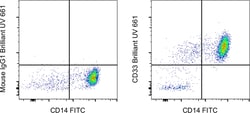Learn More
Invitrogen™ CD33 Monoclonal Antibody (WM-53 (WM53)), Brilliant Ultra Violet™ 661, eBioscience™, Invitrogen™
Mouse Monoclonal Antibody
Supplier: Invitrogen™ 376033841

Description
The WM-53 mAb reacts with human CD33, also known as GP67 and P67, a 67 kDa type I transmembrane glycoprotein that is a member of the Siglec (sialic acid-binding Ig superfamily lectin) family. It is highly specific to the hematopoietic compartment and is expressed on monocytes, activated T cells, granulocytes, myeloid progenitors, and mast cells. Applications Reported: This WM-53 (WM53) antibody has been reported for use in flow cytometric analysis. Applications Tested: This WM-53 (WM53) antibody has been pre-diluted and tested by flow cytometric analysis of normal human peripheral blood cells. This may be used at 5μL (0.25μg) per test Brilliant Ultra Violet 661 (BUV661) is a tandem dye that emits at 660 nm and is intended for use on cytometers equipped with an Ultraviolet (355 nm) laser. Please make sure that your instrument is capable of detecting this fluorochrome. When using two or more Super Bright, Brilliant Violet, Brilliant Ultra Violet, or other polymer dye-conjugated antibodies in a staining panel, it is recommended to use Super Bright Complete Staining Buffer (SB-4401-42) or Brilliant Stain Buffer (00-4409-75) to minimize any non-specific polymer interactions. Light sensitivity: This tandem dye is sensitive to photo-induced oxidation. Please protect this vial and stained samples from light. Excitation: 350 nm; Emission: 660 nm; Laser: Ultraviolet Laser.
CD33 is a transmembrane protein of the sialic acid-binding immunoglobulin-like lectin (Siglec) family. It belongs to the immunoreceptor tyrosine-based inhibitory motif (ITIM)-containing molecules able of recruiting protein tyrosine phosphatases SHP-1 and SHP-2 to signal assemblies, and these ITIMs are also used for ubiquitin-mediated removal of the receptor from the cell surface. CD33 is expressed on cells of myelomonocytic lineage, binds sialic acid residues in N- and O-glycans on cell surfaces, and is a therapeutic target for acute myeloid leukemia. Further, CD33 is found on granulocyte and macrophage precursors in the bone marrow, but is not on pluripotent stem cells. CD33 is also expressed on, and is a useful marker for, peripheral monocytes. CD33 is useful for distinguishing myelogenous leukemia cells from lymphoid or erythroid leukemias. Diseases associated with CD43 dysfunction include gallbladder lymphoma and extracutaneous mastocytoma.
Specifications
| CD33 | |
| Monoclonal | |
| 5 μL/Test | |
| PBS with BSA and 0.09% sodium azide; pH 7.2 | |
| P20138 | |
| CD33 | |
| Affinity chromatography | |
| RUO | |
| 945 | |
| 4°C, store in dark, DO NOT FREEZE! | |
| Liquid |
| Flow Cytometry | |
| WM-53 (WM53) | |
| Brilliant Ultraviolet 661 | |
| CD33 | |
| CD33; CD33 antigen; CD33 antigen (gp67); CD33 molecule; CD33 molecule transcript; FLJ00391; gp67; Myeloid cell surface antigen CD33; p67; sialic acid binding Ig-like lectin 3; sialic acid-binding Ig-like lectin 3; SIGLEC3; Siglec-3 | |
| Mouse | |
| 25 Tests | |
| Primary | |
| Human | |
| Antibody | |
| IgG1 κ |
The Fisher Scientific Encompass Program offers items which are not part of our distribution portfolio. These products typically do not have pictures or detailed descriptions. However, we are committed to improving your shopping experience. Please use the form below to provide feedback related to the content on this product.
